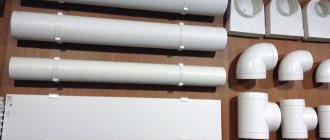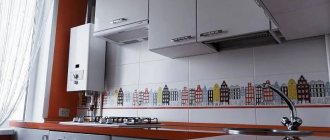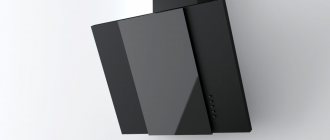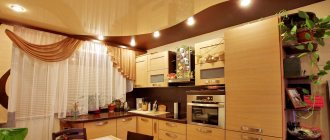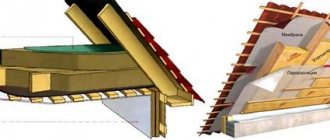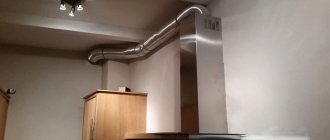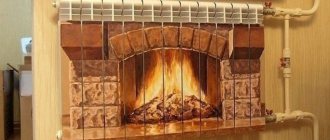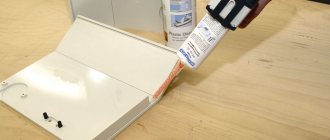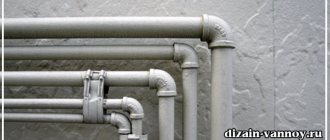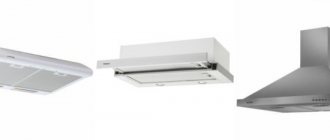Why hide pipes?
There are two types of kitchen hoods.
Circulating hoods that purify the air using a filter and return it back to the room. They do not require connection to the ventilation shaft of the building; therefore, they do not require an air duct and do not need to mask anything.
Flow hoods that remove polluted air from the kitchen. They clean much more effectively, but require connection to the ventilation system through a corrugated hose, which has an unattractive appearance that does not decorate the interior of the kitchen. In addition, if the ventilation shaft is located on the other side of the kitchen, the length of the air duct can be several meters. Therefore, the question of hiding the exhaust pipe arises simultaneously with the process of installing the entire system.
Types of hoods
The most common solution is a hood, which is installed under a wall cabinet. It has a flat shape and is in no way related to stretch ceilings. For this reason, we will not consider this option. Our task is to make a hood under a suspended ceiling. At the same time, the canvas should not be damaged. Hoods for tensile structures are divided into the following types:
- Ceiling. Placed anywhere on the ceiling structure. The main function is to remove air masses into ventilation. 1
1 - Kitchen. Installed above the stove. There is an air outlet for ventilation. 1
The installation of these types of hoods is almost the same, despite their different purposes.
Methods for masking pipes
Instead of corrugation, you can use a plastic pipe of round or rectangular cross-section, suitable in size for the diameter of the channel. To connect short sections, adapters of various configurations are used. The disadvantage of a plastic pipeline is the loss of traction when it is long. Therefore, it is recommended to use such a plastic box only if there is a ventilation hole next to the hood.
You can decorate a corrugated sleeve in the following ways.
- A box made of plasterboard. It is built on a frame made of metal profiles and then painted in a color that matches the design of the kitchen.
- Built-in furniture. The air duct is inconspicuously placed in the walls of a high wall cabinet suspended above the stove. This option is suitable in the case of a built-in hood mounted at the bottom of such a cabinet.
Both options can be combined with lighting made from LED elements, which will add comfort and brightness to the lighting in the kitchen.
- Cornice of a kitchen set. The exhaust pipe is passed close to the wall along the top of the kitchen furniture, and it becomes closed behind the cornice.
- Suspended or stretch ceiling. In this case, the corrugated pipe will be completely hidden. The ceiling height will lose from 13 to 15 cm.
- Decorative elements or painting of corrugation, which will act as an element of the kitchen interior.
If your kitchen is decorated in a high-tech style, the aluminum corrugation can be left as is, without masking. It goes well with this style.
Installation
The hood is installed at the end, after installing furniture in the kitchen or bathroom.
Very important! The devices must be located at least 55 cm from the hob. If there is a gas stove in the room, then in this case the distance is 65 cm. It is better to place the device in the bathroom with a margin of 10-15 cm.
Installation involves the use of the following tools:
- anchor bolts and dowels (included);
- wrenches;
- screwdrivers;
- sockets with grounding.
Ventilation under a suspended ceiling in a bathroom
The process itself is not difficult if you follow the subtleties and nuances.
Which way is better
The most rational camouflage option will be the one that best suits the interior of your kitchen.
The simplest way is to replace the corrugation with a plastic air duct. But we must take into account that it is effective only when the hood is located close to the ventilation hole. In addition, the plastic box must fit into the color design of the kitchen. Otherwise, it will have to be painted or covered with suitable wallpaper.
If the sleeve is long and extends across the entire room, then the best option would be a suspended ceiling that allows you to completely hide the exhaust pipe.
The cheapest option would be to paint the corrugation and decorate it with simple decorative elements.
Exhaust ventilation behind a suspended ceiling with air ducts
The lack of a ventilation system in most cases leads to the formation of mold and mildew under the suspended ceiling; sagging of the ceiling, vibration of the canvas, etc. Dampness and mold create an unpleasant odor in the room, and can also affect not only the ceiling, but also the walls. Thus, accumulating condensation creates the danger of short-circuiting the electrical wiring located behind the suspended ceiling.
You can install the ventilation system yourself, but if you have no experience in this type of work, it will be better to trust the specialists. This is especially true for creating artificial ventilation, since this process is more complex.
Before stretching the ceiling sheet, it is necessary to design and install the air duct.
In city apartments, natural ventilation systems have already been created, and for it to work, you just need to cut a hole in the stretch ceiling and install a ventilation grill in this place.
In a private home, you will have to do everything yourself, or resort to the help of a specialist.
A hole is made for each air duct outlet (usually they are made in the kitchen and bathroom, as well as in the toilet, if the bathroom in the room is separate).
It is very important to ensure the tightness of this structure. If the seams and joints of the air channel are insufficiently tight, depressurization will occur, which, in turn, in most cases can lead to the appearance of an area of negative pressure. As a result, the stretch ceiling will “suck” to the base surface, revealing everything that they wanted to hide under the stretch ceiling.
After all operations are completed, ventilation grilles are installed as described above.
Requirements for materials for sealing pipes
Materials for masking pipes can be metal, plastic, wood and drywall.
Structures that hide air ducts and other communications serve not only for decorative purposes, but also reduce the noise of the hood electric motor. They must look aesthetically pleasing, be highly resistant to elevated temperatures and moisture, chemical influences, ultraviolet radiation, and be easy to maintain and clean from dust and other contaminants.
Plastic is quick and easy to assemble, easy to process, and light in weight. Its disadvantages are tarnishing over time and susceptibility to mechanical stress.
Stainless steel boxes have a special design, are reliable in strength, and do not change their appearance. The disadvantages include the heavy weight of the structure, bulkiness and high price.
Drywall has gained great popularity as a finishing material. It is affordable and easy to install, which allows you to assemble structures from it yourself, without the involvement of craftsmen. A gypsum plasterboard box can be painted, puttied, finished with wallpaper, tiles, and mosaics. During installation, the fragility of the material must be taken into account.
Wood, if well processed, will harmoniously combine with the facade of a wooden kitchen set, reliably performing protective functions.
How to choose a ventilation pipe for an exhaust hood?
There are two main types of pipes for kitchen hoods: aluminum and plastic.
The plastic ventilation pipe can have a rectangular or round cross-section. Usually smooth and hard white.
When choosing between square and round sections, it is recommended to pay attention to the second option. A round diameter is more efficient because it allows air flow to pass unhindered.
The rectangular shape looks more unconventional and is easier to disguise in the interior.
Advantages of plastic pipes:
- Easy to care for thanks to its smooth shape and specific material.
- Silent operation, which also depends on the characteristics of the plastic.
- Ease of masking, painting and any processing.
- Insensitive to moisture.
- Long service life.
The disadvantages of plastic products include the high price and installation features: selection of adapters and corner fasteners, as well as careful attention to maintaining the tightness of the structure.
Sealants are used to reliably isolate joints.
Corrugated aluminum pipes are no less popular than plastic ones. The corrugations are made of medium-hard aluminum. This design can be used in compressed and extended form, depending on the length of the air duct required in each particular case.
Advantages of corrugated pipes for kitchen hoods:
- Easy to install. The connection is made using clamps, making the structure easy to assemble and disassemble.
- The corrugation can be stretched to the desired size.
- Budget cost.
- Corrugations can have different sections, both round and square, making it easy to choose an option for a specific ventilation outlet.
- Suitable for non-standard kitchens.
- Can be cut with scissors.
- Resistant to extra-high temperatures.
The corrugated exhaust pipe also has disadvantages:
- Assemblies can accumulate contaminants that are not so easy to remove.
- Corrugation cannot be painted.
- The presence of several assemblies with the same clamps negatively affects the tightness of the structure.
- It is easier to stretch a corrugation than to compress it back.
- Specific appearance.
Also, the advantages of an aluminum air duct include the ease of replacement if necessary.
Do-it-yourself pipe masking
You can install decorative boxes yourself, even without having great home craftsmanship skills. Here it is important to decide in advance on the pipe finishing option, select the right material and fasteners.
Required tools and materials
The following set of tools will be needed:
- electric drill;
- screwdriver;
- perforator;
- scissors for working with metal;
- for working with wood and drywall - a jigsaw;
- ruler;
- level.
For fastening you should purchase:
- dowels of the required size;
- self-tapping screws;
- metal profiles;
- mounting screws;
- clamps for fastening the air duct.
Before purchasing materials, you should determine the dimensions of the structure and calculate the volume of purchase.
Work progress
To hide the corrugation, a decorative box of plasterboard is most often constructed.
- Work begins with measuring the space and air duct, and sketching out the installation project.
- Using a ruler and level, mark with a pencil on the wall. Along the wall, and then along the ceiling, guide profiles are attached with dowels, then vertical sections are attached to them with self-tapping screws.
- The corrugated sleeve is fixed in the openings of the hood and ventilation shaft, placing it inside the frame.
- The frame is covered with plasterboard along the profiles using self-tapping screws.
- The manufactured box can be finished in accordance with the interior of the kitchen: painted, wallpapered, or used other materials.
Plasterboard ceiling
This system is most popular due to its affordable price, durability and compliance with the modern design trend, according to which the surface above the head should not attract too much attention - it is enough that it is flat, smooth and monochromatic.
Before installing a plasterboard or suspended ceiling, the ventilation system should be tested for several days, since subsequently it will be difficult to eliminate defects (vibrations, air leaks, insufficient flow speed).
The basis of a plasterboard ceiling is a frame made of galvanized steel profiles, which is attached to the walls and/or floor slab. The configuration of the profiles and the type of hangers for fastening to the ceiling are selected taking into account many factors, such as the area of the room, the distance from the slab, and the year the building was built. The simplest load-bearing structure consists of parallel profiles located with a pitch of 600 mm between the axes, however, it does not have its own rigidity, and the vibrations of the floor are transferred to it unevenly, as a result of which hairline cracks sometimes appear at the joints of the sheets. Much more reliable are single- and two-level lattice frames mounted using cross-shaped connectors (standard KNAUF P112 and P113 systems).
If the ceiling height is small, you can install plasterboard boxes around the perimeter of the premises to lay ventilation ducts. Photo: dmitrimaruta/Depositphotos/Fotodom.ru
A plasterboard ceiling can be mounted at any level: if the distance from the ceiling does not exceed 200 mm, the frame is suspended on brackets (so-called direct hangers); if it exceeds it, adjustable sliding hangers with clamps or sections of the supporting profile are used. The pitch of the hangers is chosen taking into account the mass of the structure and operational loads (say, with a mass of up to 15 kg/m2 it should be 1000–1100 mm). The frame is most often sheathed with one layer of gypsum board 12.5 mm thick; When using sheets with a thickness of 9.5 mm, frame profiles and suspensions need to be placed more often, which is irrational.
Drywall cornice boxes are often combined with a glossy tension “middle”. Photo: ThreeDiCube/Depositphotos.com
After installation, the joints of the sheets are expanded, giving them a wedge-shaped shape, and then puttied with elastic non-shrink putty. If the ceiling is subject to strong vibrations or the building has not yet shrinked, the frame is sheathed in two layers with overlapping joints.
Ventilation grilles are cut into the ceiling as the gypsum boards are attached and connected to the ducts, as a rule, using corrugated hoses.
A plasterboard ceiling will cost 800–1200 rubles. for 1 m2.
Expert advice
Let's look at some of the nuances of masking the exhaust pipe.
When choosing a plastic air duct, it is important to ensure that its diameter is no less than the diameter of the ventilation shaft opening.
A plastic sleeve over 3 meters long is not the best solution.
Additional LED lighting will really transform the kitchen space. It will help make the projection of the box invisible, or, conversely, highlight it in the kitchen facade.
If the ventilation shaft opening is located away from the hood, the sleeve can be rotated and laid through the side wall of the next wall cabinet.
How to mask heating risers
Heating risers are masked in several ways.
Seal the pipes into the wall or floor. The method is labor-intensive, but its main drawback is that if the pipe is damaged or leaks, the wall or floor will have to be dismantled.
The pipes are hidden with a decorative plasterboard box. Mark the place for attaching the metal frame, taking into account that there must be at least 3 cm of space between the pipe and the box. The frame is secured with horizontal jumpers. Then it is sheathed with gypsum board sheets. The joints are covered with sickle tape, putty, and rubbed. Next, the box is decorated with decorative materials or painted to match the color of the room.
In a similar way, you can disguise sewer pipes, water pipes, and, subject to safety precautions, gas pipelines.
It is better to camouflage such communications during the period of their installation, which will allow the boxes to be installed as discreetly as possible.
What is better: plasterboard box or suspended ceiling?
The ceiling will completely hide the sleeve, it will not be visible. But if you have a ceiling below 2.60 in the kitchen, then the option of placing the air duct above the suspended ceiling is excluded.
The plasterboard box will only disguise the exhaust pipe, leaving a protrusion. But if the device fits into the interior, that will be enough.
A suspended ceiling made of panels or ceiling tiles can be easily disassembled if necessary. Sometimes it is necessary to dismantle only the part of the structure located under the air duct.
How to install corrugation on a hood
Corrugated air ducts are soft, weightless aluminum products. Easy to install, bend well at any angle.
During installation, it is better to stretch the corrugation so that subsequently dirt does not accumulate in its ribbed surface.
The diameter of the sleeve should either match or slightly exceed the size of the outlet of the hood. A plastic cylinder with a check valve is installed in this hole.
The end of the corrugation is put on this cylinder and secured with a clamp. The other end of the corrugation is connected in the same way to the ventilation hole through a special air duct. Turn on the hood and apply a sheet of paper to it. If the paper holds, then there is traction.
Types of hoods and their features
Hoods can be circulating or flow-through. Both options have their pros and cons, so everyone chooses the most appropriate solution for themselves, based on capabilities and preferences:
- A circulation hood, the air purification work of which is based on the use of a grease-collecting carbon filter, does not have an air duct. The filters used need to be periodically replaced, but it is always possible to place the stove anywhere, because there is no need to connect it to the location of the ventilation duct.
- Flow hood, thanks to which the polluted air is completely removed into the ventilation shaft through a special air duct. This hood is simple and easy to maintain, but its installation requires connecting the hood to the ventilation shaft of the building. When choosing this model, you will have to think in advance about how the exhaust pipe does not spoil the appearance of the kitchen, and to do this you will have to additionally fork out for the consumables necessary for high-quality masking of the air duct.
We recommend that you read: Advantages of corrugated stainless steel pipes
Note! The circulation option is highly expensive compared to the flow option, and not only is the purchase more expensive, but also the operation, since exhaust filters require frequent replacement.
Flow hoods are made from various materials: PVC, plastic, aluminum, galvanized steel. The material used to make the range hood vent also often determines the choice of camouflage options.
- PVC is the most affordable type of air duct, made from an inexpensive synthetic material that does not make noise during operation. It is relatively inexpensive, the pipes can be painted and given absolutely any color shade, so as not to change the original style of the kitchen space. There are air ducts with a round or rectangular cross-section. The first one has less air resistance, so it is considered the most effective. Rectangular is easier to install and combine with the kitchen interior, decoration and kitchen furniture. Many options for connecting elements allow you to create any configuration.
- Corrugation. It is made of aluminum, there is a corrugated version made of galvanized steel, it has a smooth surface and does not rust. For installation, additional fasteners (clamps that are secured with bolts) and adapters are usually used. One end of the pipe is attached to the outlet of the hood, the other to the ventilation duct.
Common mistakes
The most common mistakes are made when installing corrugated or plastic air ducts. Thus, to install a plastic or corrugated pipe, it is important that its cross-section matches or exceeds in size the area of the air purifier outlet pipe. When purchasing hoses and exhaust equipment, you should pay attention to this.
The corrugated pipe must be installed as stretched as possible, which is not always observed. Its bends should not be less than the diameter of the corrugation itself.
When laying a plastic pipeline, the bend angles must be obtuse.
Plastic pipes
A simple and at the same time original way to disguise a pipe from an exhaust hood is a plastic air duct. Since in a standard apartment the ventilation ducts run far from household appliances and stoves, residents have to independently assemble the structure, which will consist of sections, sleeves and other elements. Thanks to the wide range of selected materials, you can choose the desired shape with a specific cross-section.
Most often, a plastic air duct has a round or rectangular cross-section, each of which has its own differences and advantages.
- The circular cross-section allows for less air resistance, which means the air duct will be highly efficient.
- Pipes with a rectangular cross-section easily harmonize and match with almost any interior, decoration, and kitchen set.
As you know, modern plastic pipes have a number of advantages:
- lower noise level during operation in contrast to metal corrugation;
- no greasy deposits remain on the walls of the pipes, since all vapors and waste go directly into the shaft;
- no resistance during operation.
Note!
If you prefer plastic pipes, you need to make calculations and buy all the necessary parts, including connecting elements.
This type of pipe is the easiest to install. To do this, one end is fixed to the hood, and the other to the ventilation duct. Special round clamps are used as fasteners, which are tightened with bolts.
The diameter of the pipe may be larger than the diameter of the hood, so the clamp is pressed tightly against the adapter. You can find an alternative - galvanized pipes. They do not rust and completely remove kitchen odors. There are different duct systems: flanged, welded and wafer.
Note!
The pipe exit from the corrugation has a square cross-section, and the adapter should be round. When making purchases, pay attention to the need to purchase the appropriate adapter.
Why do you need to hide the pipe from the hood?
In total, 2 types of hoods are used - circulation and flow. A characteristic feature of circulation ones is that they pass air through filters installed inside, which must be changed periodically. They are expensive and therefore buyers are more willing to choose another type of kitchen appliance.
Flow hoods, being a fairly budget option, provide high efficiency in processing ambient air. They are often chosen by buyers for whom savings are important. The peculiarity of this type of hoods is that they are connected directly to the ventilation through an air duct. Due to the fact that the shaft itself, as a rule, is located at a considerable distance from the hood, there is a need to hide the hose that will stretch along the wall. There are several ways to solve this problem.
REFERENCE! Using a hood is not enough to completely clean the air. Be sure to ventilate the room 2 times a day.
Video: example of masking pipes in the kitchen
Instead of corrugated round pipes of the ventilation system, use flat plastic air ducts with a rectangular section of 55x110 mm and hide them behind a suspended ceiling! Rectangular PVC channels pressed as close as possible to the base ceiling
, especially if the project uses GX53 recessed luminaires.
Pay special attention to sealing the ventilation connections so that the hood does not blow air out of the kitchen behind the canvas! Otherwise, when you turn on the hood, the stretch ceiling will inflate and sag. Another important point! If the duct from the hood passes through other rooms, for example, a bathroom or toilet, and you are going to build ventilation into it for these rooms, be sure to use diffusers with a check valve! Otherwise, when you turn on the kitchen hood, dirty air will be released into neighboring rooms.
The ventilation system made of flat plastic air ducts has many different bends and adapters for bypassing corners, turns and connections with the exhaust system, which are sold in any large hardware stores and supermarkets in Samara, Togliatti and Syzran. The entire range of household ventilation system elements can be purchased from a warehouse in Tolyatti.
To connect to the hood, use a rectangular transition to a round corrugated pipe, which usually comes with the hood itself! After installing the stretch ceiling, specialists will make a hole in this place of the required diameter to connect the corrugation, which will subsequently be covered with the hood casing.
The final version of the kitchen with hidden placement of hood ventilation elements behind the suspended ceiling in the photo
An alternative way to rid the kitchen of external ventilation communications is to install a two-level stretch ceiling. It is enough to lower the level only above the cooking area or above the cabinets.
A multi-level stretch ceiling can be made according to the shape and matched to the color of the facades of the kitchen unit.
A 2-level ceiling may consist partly of a plasterboard structure around the perimeter and an internal part of a stretch ceiling, as in the photo below from a completed project by the VAGON architecture and design studio with the participation of.
thanks his talented partner - designer Vahagn Mikaelyan - for providing photos of suspended ceilings!
See other interesting ideas for kitchen interior design with suspended ceilings in our separate section!
We hope that our useful advice will help you avoid mistakes in repairs.
The kitchen hood has become an indispensable attribute of every home. The functionality of this device depends on its operating principle. There are two types of models - circulation and drainage. The first type of device drives polluted air through filters, returning it back. Flow mechanisms carry out cleaning better, because smoky air and burning particles are completely removed through the hood air ducts.
Ways to hide a pipe from a hood
The exhaust arm, as a rule, is large in size, thereby affecting the aesthetics of the interior. It is difficult to install it so that it does not catch the eye and does not disrupt the design of the kitchen. In order to disguise this element, owners choose different methods.
Construction of a plastic box
The boxes have round, square or rectangular shapes.
The plastic version of the box has a number of advantages unique to it:
- low price category;
- long service life;
- ease of installation and maintenance;
- almost complete silence;
- hygiene.
Over time, the box will change color, but if the air duct is correctly located behind the furniture, this aesthetic flaw will not play any role. This type of camouflage is optimal when the hood and ventilation shaft are located close together.
IMPORTANT! Most professionals recommend caulking joints to increase strength. But this can make it difficult to clean the inside of the box, especially one with a lot of bends. Therefore, you should not seal them if the structure is small in length and has additional support in the form of a cabinet roof or something else.
The plastic box can be easily installed even at home, assembled according to the “socket-pipe” principle. Many connecting elements will solve the problem of a large number of corners and obstacles in the kitchen. If necessary, you can manually adjust the pipes, because plastic is easy to saw.
To fully assemble the box you must have:
- main pipes;
- adapters;
- knee;
- connectors;
- anti-return valve;
- grate.
With the help of the listed elements, there will be no problems in assembling a structure of any length.
Disguise under a suspended or suspended ceiling
Very often, when the question of masking an air duct arises, installers recommend hiding the element under a suspended or suspended ceiling. The pipe, with this type of camouflage, is not visible at all, but in case of damage it will have to be completely disassembled. There is also a minimum ceiling height limitation. So, if the ceiling height in the kitchen is less than 2.6 m, then it will not be possible to hide the box.
Construction of a plasterboard box
The most economical type of masking of an air duct is a box assembled from plasterboard sheets. This material fits perfectly into any interior. This design does not have any special installation difficulties and does not require large financial expenditures.
Due to the peculiarities of its structure, it cannot serve as an air duct, so drywall serves as a decor covering the corrugation.
IMPORTANT! Drywall must be waterproof so as not to collapse under the influence of the humid microclimate of the kitchen.
The main advantages of a plasterboard box are:
- variety in the choice of form;
- Possibility of choice of final finishing;
- low cost.
How to close the corrugation from the hood in the kitchen by building a channel through the furniture
Another way to hide the corrugation is to embed it in the cavity of a wall cabinet. The advantage of this method of disguise is the ability to preserve the original interior of the kitchen and increase the functionality of the furniture by using its free space. To achieve these goals, it is recommended to design custom-made furniture so that the design already includes the possibility of hiding the corrugation. A plus will be the ability to easily dismantle and replace pipes if necessary.
To successfully install the hood and its air duct into the cabinet, do the following:
- construct a valve from aluminum to prevent air from entering the room from the ventilation;
- make a hole for it on the top of the cabinet, place the valve in this place, subsequently attaching it using assembly adhesive;
- remove the element of the kitchen unit and, using a jigsaw, cut a hole in its bottom, focusing on the dimensions of the hood;
- remove the shelves and cut holes in them for the air duct;
- make a hole in the top shelf for the valve, leaving an allowance on each side of 3 mm;
- place the piece of furniture on the back wall and insert the corrugation;
- form the upper edge of the corrugation into a square in order to insert it into the hole;
- cut the inserted edge of the corrugation along the edges and bend it;
- install the cabinet in place and insert the valve into the ventilation.
Finally, install the hood into the hole cut out in the bottom of the cabinet, securing it with screws. The corrugation is put on the pipe and secured with a clamp.
Why do you need a hood?
The need for a hood in the kitchen is obvious:
- it eliminates odors (no matter whether you are cooking or smoking, the hood will do an excellent job of removing all types of odors);
- ventilates the room (modern hoods are equipped with a ventilation function);
- balances temperature changes (during cooking, the air temperature above the stove rises and then drops sharply, this greatly affects all decorative elements and furniture in the house).
